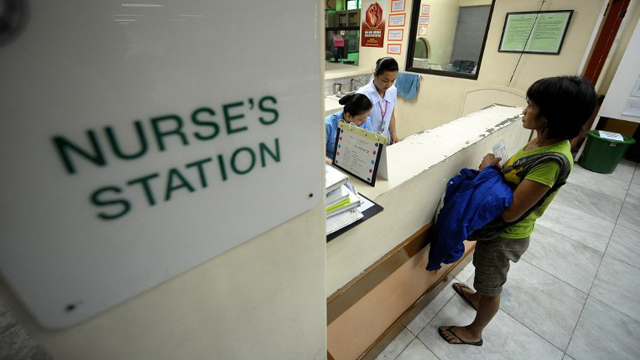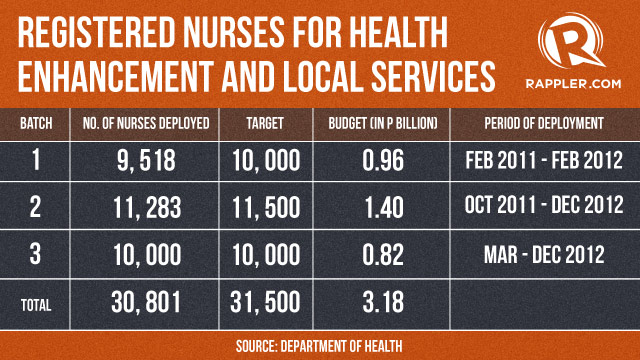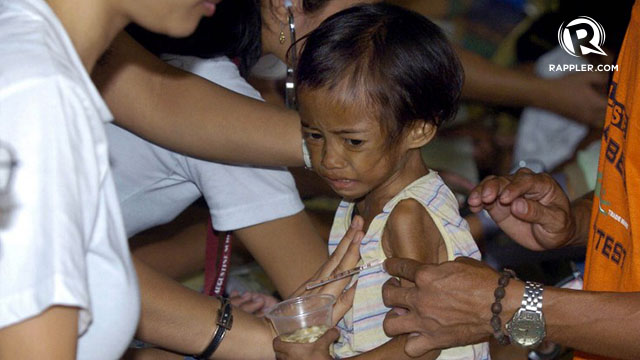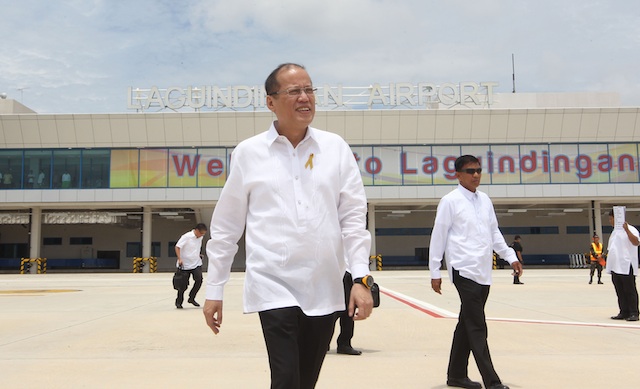SUMMARY
This is AI generated summarization, which may have errors. For context, always refer to the full article.

MANILA, Philippines – Thirty-year-old housewife Evelyn Bautista-Dumangas rushed her crying 3-year-old son to the Kitcharao District Hospital in Agusan del Norte province, only to find out there was no stay-in doctor to attend to their needs.
With insufficient money and an increasing concern over the inflammation of her child’s body, Evelyn traveled for 3 hours to Butuan City to avail of public health services.
In Butuan City, there is only one primary care doctor for every 100,000 residents. The district health center based in the barangay (village) of Ampayon serves 35 other barangays. The district doctor is unable to visit all barangays in a week.
The Butuan Medical Center – the city’s public hospital where Evelyn’s son is now admitted – services close to 200 patients a day, more than double its bed capacity based on its Department of Health (DOH) license.
Dr Jennifer Chua, the hospital director, is not embarrassed to appeal for funding from external sources. “Kailangan talaga namin dito,” she explained. (We really need it here.)
Challenges
Despite the progress cited by President Benigno Aquino III in previous State of the Nation Addresses (SONAs), the country’s public healthcare system is marred with problems. The lack of health personnel, the absence of adequate facilities, and the remaining barriers for the poor to access health care are just some of these problems.
According to the 2012 Philippines Health Service Delivery Profile, a collaboration between the DOH and the World Health Organization (WHO), only 4 of the country’s 17 regions meet the acceptable hospital bed to population ratio.
In the proposed 2014 budget to be transmitted by Malacañang to Congress for review, P87.1 billion has been allocated to the DOH, almost 50% higher than their 2013 allocation.
Jossel Ebesate of the Alliance of Health Workers, however, is not impressed with the figure, citing its non-compliance with international standards.
“Kahit anong sabi ng gobyerno na malaki daw ang in-allocate this year, it could not hide the fact na yung sinasabing pondo na yun ay napakalayo pa rin sa hinihinigi o prescribed ng WHO na 5% ng ating Gross Domestic Product (GDP),” he said.
(Whatever government may say about the increase in funds this year, it could not hide the fact that the allocated budget is still far from the WHO-prescribed health expenditure at 5% of GDP.)
Ebesate also cited that only 17,000 – not even half – of the country’s 42,000 barangays have health centers. He added that midwives assigned to health centers in remote barangays only get to visit two to 3 times a week.

RNHeals exploits?
In President Aquino’s 2012 SONA, he cited DOH’s Registered Nurses for Health Enhancement and Local Service (RNHeals) – a training program which deployed nurses to unserved and underserved areas of the country – as a tool to address the lack of public health personnel in the local level.
“This new system addresses two issues: thousands of nurses and midwives now have jobs and an opportunity to gain valuable work experience; at the same time, millions of our countrymen now have increased access to quality health care,” said the president in Filipino.
Health Secretary Enrique Ona explained that the nurses under the RNHeals program are not employed but are considered “pre-service trainees” deployed to priority areas of the government.
While the program has been consistent with its set targets, it has been criticized as “exploitative” by a number of nurses’ association.
Leah Paquiz of Ang Nars partytlist group said that the licensed nurses shouldn’t be treated as trainees, as they already had their Related Learning Experience (RLE) which provided theoretical and clinical training during their years in college.
“Nurses should be employed with employer-employee relationship, [with] salary grade 15, be given benefits, and be given security of tenure,” Paquiz said.
She added that being hired as employees in government-run health hospitals and centers – that is, new job openings for health professionals – is better than a program which she says only temporarily addresses the lack of personnel.
Nurses enrolled in the program are given a monthly allowance of P8,000 from the DOH, with no other benefits. The local governments in areas where the nurses are deployed are encouraged to provide an additional P2,000 allowance along with a P1,500 travel allowance.
Reports of late disbursements are rampant, but the government continues to assure the nurses that funds will be released. DOH offices have appealed for the patience of the RNHeals health workers in waiting for their allowances.
In January, DOH deployed its 4th batch of RNheals nurses. The department bars nurses who already went through the program from applying again. The training runs for a year.
“It does not help curb the lack in government health care personnel, because this is temporary. It does not hone the competencies of nurses,” said Paquiz.

Vaccination program
On the 4th SONA set to be delivered Monday, July 22, the president is expected to mention the health department’s campaign against pneumonia.
The DOHbol Time Laban sa Polmonya (Fight Against Pneumonia) intends to provide free vaccinations against the respiratory infection to some 2.4 million infants between 6 months to one year old.
The program, which was launched 5 days before the 2013 SONA, seeks to address the alarming number of infant deaths caused by the disease. Itis estimated to save P23,500 in healthcare costs per infant.
READ: The fight against pneumonia
Since the start of Aquino’s term, the DOH has introduced two additional vaccines to its Expanded Program on Immunization (EPI). The president mentioned the integration of the Rotavirus Vaccine to the DOH-EPI in the 2012 SONA.
Under the current administration, Republic Act 10152 or the Mandatory Infants and Children Health Immunization was signed into law.
RA 10152 mandated local health centers and government-run hospitals to provide free vaccinations against 8 outlined diseases as well as others that may be determined by the health secratary for children 5 years old and below.
The current DOH-EPI budget allocation — which also covers for the implementation of RA 10152 — is at P2.4 billion.
Dr Joyce Ducusin, DOH-EPI national coordinator, said the strong growth in the nation’s economy paved the way for a budget increase.
Public health coverage
In last year’s SONA, Aquino made mention of the increased number of memberships to the National Health Insurance or PhilHealth – the country’s public health insurance system. He said 85% were currently enrolled at that time, a far cry from the 65% enrollment rate before he took office.
On June 21 this year, Aquino signed into law the expansion of PhilHealth to include indigents and the informal sector – not just premium-paying members – in an effort to move closer to the goal of universal health care coverage.
According to Assistant Secretary Eric Tayag of the DOH, the proposed 2014 budget increase for the health department is primarily intended to subsidize healthcare for the poor through PhilHealth.
Reproductive health
Also under the Aquino administration, Congress passed the Reproductive Health (RH) law and the Sin Tax law — two laws that will empower Filipinos to make better health choices.
The implementation of the RH law is on hold pending deliberations in the Supreme Court, which extended the RH law’s status quo ante order.

Teen pregnancy
Teenage pregnancy is also on the rise. According to the 2011 Family Health Survey of the National Statistics Office, 9.5% of women aged 15 to 19 are either pregnant or have already given birth.
WATCH: Children bearing children
“Adolescent mothers are 4 times more likely to die during labor than adult moms,” said May-I Frabros of WomenHealth Philippines.
Dr Juan Antonio Perez III, DOH Director IV, said counseling services should be made accessible to teenagers and service-providers should be more sensitive to teenagers’ sexual curiousity.
Prevention over cure
Anti-tobacco advocates lobbied for 15 years to levy additional taxes on booze and tobacco – a feat they say is even more laudable as it was approved under a chief executive who himself is a smoker.
A lion’s share of the Sin Tax collection is allocated to finance the expanded PhilHealth coverage, which will provide the poorest of the poor access to free and quality treatment in public health facilities. It will also fund the building of new clinics and hospitals.
But advocates say more can be done in the implementation of the Sin Tax law, specifically in allocating portions of the revenue collected to health promotion efforts instead of solely for healthcare coverage.
Health promotion deals with prevention rather than the treatment of diseases – these include bringing down smoking prevalence, promoting regular exercise and proper nutrition, and addressing risk factors of non-communicable diseases.
READ: ‘PH lags behind in health promotion’
“While we have recently increased taxes on tobacco and alcohol, the Philippines overlooked an opportunity when we neglected to allocate part of the sin tax revenue for preventative health care,” said Irene Reyes of HealthJustice Philippines.
On July 20, two days before the 2013 SONA, HealthJustice Philippines urged President Aquino to invest in health promotion. It echoed previous calls to reform a healthcare system “favorably biased to managing illness rather than encouraging wellness.”
“By allotting a percentage of the excise tax revenue for HP, Thailand was able to fund various programs that improved their overall national health,” said Dr. Ulysses Dorotheo of the Southeast Asia Tobacco Control Alliance.

Moving forward
Health laws such as the mandatory graphic health warning on cigarette packs may need support from Malacañang for its passage in Congress, given the strong industry lobby.
There are those like Ebesate of the Alliance of Health Workers who are wary of possible privatization of public hospitals, which they say may cause healthcare costs to go up based on the experience of countries abroad.
“I hope he [President Aquino] has better plans for the health of the people. Tamang trabaho, tamang solusyon [para] sa mga (The right jobs, the right solution for) health workers,” said Paquiz of Ang Nars.
“To our President, we urge you to follow-through on your promise to invest in preventive health care. Only then does the country stand a chance in winning the battle against non-communicable diseases,” said Reyes of HealthJustice Philippines.
With only 3 years left to institutionalize reforms and strengthen existing policies in the country’s health care system, President Aquino will need all the help he can get. – Rappler.com
Add a comment
How does this make you feel?
There are no comments yet. Add your comment to start the conversation.